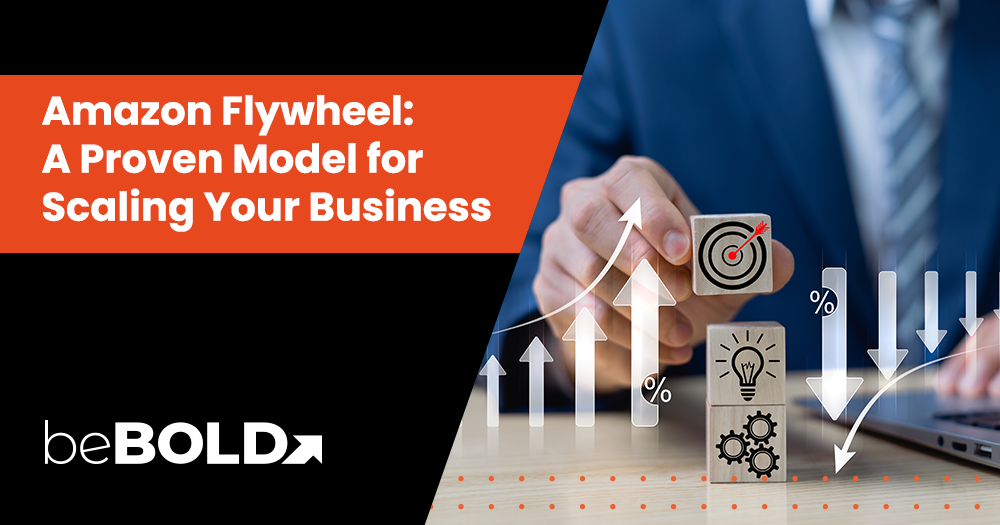Key Highlights
- The Amazon Flywheel drives growth by focusing on customer experience, pricing, and traffic, creating a self-reinforcing cycle.
- Minor improvements in product listings, fulfillment, and reviews can trigger larger growth, driving long-term success through the Amazon Flywheel model.
- By focusing on customer experience, fast shipping, excellent service, and personalization, you build loyalty, boost visibility, and fuel the Flywheel’s momentum.
- Launching products strategically based on market trends and customer feedback can accelerate growth without the need for major investments.
- Tweak listings, use PPC ads, encourage reviews, and expand your product range to keep the Flywheel spinning.
- Monitor reviews, conversion rates, traffic, and ROI to measure Flywheel's success.
- The Flywheel works for small sellers too, helping boost sales and visibility by focusing on customer service and inventory management.
- With beBOLD Digital, fuel your growth by optimizing the Amazon Flywheel, boosting customer experience, traffic, and pricing for sustained success on Amazon.
Amazon’s Flywheel is a game-changing growth model that thrives on customer focus, competitive pricing, and driving consistent traffic. For sellers, the key lies in improving listings, ensuring fast fulfillment, and garnering glowing reviews. These actions spark the cycle, leading to more sales and greater visibility. The best part? Small tweaks, such as refining your product descriptions or speeding up shipping, can yield bigger results and fuel long-term growth. Amazon’s Flywheel shows how every effort you make can compound into a massive success.
What is the Amazon Flywheel Model?

The Amazon Flywheel Model, also known as the “Virtuous Cycle,” was conceptualized by Jeff Bezos in the early 2000s as a strategy for long-term, customer-driven growth. Instead of focusing on quick wins, Bezos believed that continuous momentum, driven by prioritizing customers, would lead to unstoppable growth over time.
The flywheel starts with a focus on customer experience. A great experience attracts more customers, which increases traffic and enhances customer engagement. More traffic attracts more sellers to the platform, resulting in a wider product selection.
This, in turn, improves customer satisfaction, feeding back into the flywheel. As volume grows, Amazon achieves better economies of scale, which lowers costs and allows for lower prices, creating a loop of growth that fuels itself.
Bezos's genius lay in obsessing over the long term. He resisted shortcuts, believing that if each part of the flywheel were consistently improved, Amazon’s growth would accelerate naturally without needing to push or overspend. It’s how Amazon scaled from books to the everything store.
How the Amazon Flywheel Works?
The Amazon Flywheel—also known as the Virtuous Cycle—is a self-reinforcing loop that begins and ends with the customer experience. Here’s how it works:
- Customer Experience Comes First
Amazon prioritizes customer satisfaction above all. By offering seamless navigation, fast delivery, and reliable service, Amazon builds trust and loyalty. - Lower Prices
Competitive pricing attracts more customers to the platform. The better the deals, the more likely people are to return. - More Traffic
A great customer experience and lower prices lead to increased traffic, which creates demand and momentum across the platform. - More Sellers (Including 3P Sellers)
Amazon allows third-party (3P) sellers to list products, expanding variety without having to own all the inventory. This is evident in categories like Premium & Professional Beauty, which are now open to 3P brands—further enriching selection. - Greater Product Variety
With more sellers comes more product options, styles, and innovations. This gives shoppers more choices, increasing engagement and purchase behavior. - Increased Competition Among Sellers
More sellers competing in the same categories drive prices lower and quality higher, which again benefits the customer. - Enhanced Customer Experience
A wider selection at better prices completes the loop by delivering even greater value to the customer—restarting the Flywheel all over again.
The Flywheel's Effect on Amazon's Growth

The Flywheel’s effect is at the heart of Amazon’s unstoppable growth. As each part of the cycle gains momentum, it feeds into the next, creating a powerful force that propels Amazon forward. Here’s how it impacts growth:
- Customers First: With lower prices and a wider variety, Amazon attracts more customers, resulting in increased sales.
- Seller Surge: As sales rise, more sellers join the platform, adding greater product variety and making Amazon even more irresistible.
- Efficiency Boost: Amazon's growing scale reduces operational costs, enabling it to invest in faster delivery, improved services, and cutting-edge technology, benefiting everyone.
- Exponential Profits: As the cycle grows, so do profits, which are reinvested in the Flywheel, keeping it spinning faster.
Why the Flywheel Matters for Sellers?
The Amazon Flywheel can be extremely helpful for sellers, as small changes can lead to significant results. For example, improving your Amazon listings with better titles, enhanced images, or detailed descriptions can increase visibility, driving more traffic to your page. Faster fulfillment not only boosts customer satisfaction but also earns more positive reviews, which can help you earn Amazon badges and improve your ranking to attract even more customers.
Even a minor price adjustment can trigger an increase in sales, resulting in more traffic and higher conversion rates. These small improvements, when consistently made, feed into Amazon’s Flywheel, creating a cycle of compounding growth that drives sustained success for sellers.
Three Pillars of a Successful Amazon Flywheel

To build a strong and effective Amazon Flywheel, sellers must focus on three core pillars:
1. Customer Experience
The foundation of Amazon's Flywheel is a customer-centric approach. Offering excellent service, fast delivery, and exceptional product quality keeps customers coming back, fueling the cycle. Positive reviews and repeat purchases strengthen your Amazon presence, driving more traffic and boosting sales. In fact, 73% of consumers are more likely to trust a business with positive reviews.
Action Steps to Take: Optimize product listings with high-quality images, accurate descriptions, and competitive pricing to enhance customer satisfaction and encourage repeat purchases.
2. Drive Traffic
Attracting more customers to your listings is essential. Optimizing product listings, running effective ads, and leveraging Amazon’s promotional tools, such as Amazon Advertising, Prime Day, and deals, can boost visibility. More traffic means more sales, which keeps the Flywheel moving.
Action Steps to Take: Use Amazon ads (Sponsored Products, Sponsored Brands, and Sponsored Display ads) along with promotional tools like deals and coupons to boost visibility and drive traffic to your listings.
3. Analyze Products
Regularly reviewing and analyzing your product performance is crucial for optimization. By tracking sales data, customer feedback, and competitor activity, sellers can refine their listings and adjust their strategies. This continuous improvement ensures that your Flywheel continues to gain momentum and remains competitive.
Action Steps to Take: Regularly monitor product performance through analytics, customer feedback, and inventory levels to refine pricing strategies and improve sales efficiency.
How Can You Apply the Flywheel Strategy to Your Business?

To successfully implement Amazon’s Flywheel strategy, sellers need to focus on continuous improvement and optimization.
Here’s how you can apply each element:
|
Pillar |
Actions to Support It |
|
Prioritize Customer Experience |
Deliver top-notch products, fast shipping, and 5-star support to keep customers coming back. |
|
Optimize for Amazon SEO |
Use smart keywords, sharp copy, and crisp images to boost visibility and clicks. |
|
Launch Products Strategically |
Spot trends, fill gaps, and time launches to hit when demand peaks. |
|
Use PPC and External Traffic Effectively |
Run high-ROI ads and send traffic from socials, blogs, and influencers straight to your listings. |
|
Focus on Review Generation |
Follow up post-purchase and use Amazon tools to stack up reviews and trust. |
|
Expand Product Range |
Launch related products or bundles to capture more buyers and boost AOV. |
|
Cut Costs Without Compromising Value |
Trim supply chain fat, reduce fees, and stay lean, without hurting quality. |
|
Identify Top Sellers and Underperforming SKUs |
Double down on winners. Fix or drop what’s dragging you down. |
|
Monitor Sell-Through Rates |
Track sales speed. Move inventory smarter. Avoid stockouts or dead weight. |
|
Pricing |
Stay competitive. Test smart. Win the sale and the margin. |
1. Prioritize Customer Experience
Focus on delivering high-quality products, fast shipping, and excellent customer service. Positive experiences lead to repeat customers, boosting sales and driving traffic.
2. Optimize for Amazon SEO
Ensure your product listings are optimized with relevant keywords, clear descriptions, and high-quality images. Better visibility leads to more sales, fueling the Flywheel.
3. Launch Products Strategically
Identify market gaps and launch products that align with customer demand. Time your launches based on trends, seasons, or customer feedback for maximum impact.
4. Use PPC and External Traffic Effectively
Invest in Amazon PPC ads to drive traffic and increase product visibility. Also, leverage social media, blogs, or influencers to send external traffic to your listings.
5. Focus on Review Generation
Encourage customer reviews to improve your product ranking and trustworthiness. Positive reviews increase conversions, which fuels further growth in the Flywheel.
6. Expand Product Range
Broaden your product offering to target new customer segments and increase Average Order Value (AOV). By diversifying your inventory with related products or bundles, you not only attract a larger audience but also encourage customers to spend more, driving more traffic and sales.
7. Cut Costs Without Compromising Value
Seek opportunities to optimize your supply chain and minimize costs. Lower operational expenses allow you to reinvest in the Flywheel for even more growth.
8. Identify Top Sellers and Underperforming SKUs
Regularly analyze your product performance to identify best-sellers and underperformers. Focus on promoting the top sellers while optimizing or discontinuing slow-moving products.
9. Monitor Sell-Through Rates
Keep an eye on how quickly your inventory sells. A higher sell-through rate means better inventory turnover, helping to maximize your profits.
10. Pricing
Adjust your pricing to stay competitive while ensuring profitability. Competitive prices drive sales, feed traffic to your listings, and push the Flywheel into higher momentum.
How Effective Is Amazon Flywheel?
The Amazon Flywheel is an effective growth model that creates a cycle where increased sales attract more customers and sellers. This results in better services, more product options, and competitive pricing, further driving customer satisfaction. By leveraging this cycle, Amazon enhances its marketplace, benefiting both customers and sellers, leading to long-term success and scalability.
Which Metrics Should You Track to Measure Flywheel Growth?
To fuel Amazon’s Flywheel, track these key metrics to keep the momentum going:- Customer Experience: Focus on Order Defect Rate, Customer Reviews, and Response Time to Build a Happy and Loyal Customer Base.
- Traffic & Visibility: Monitor Sessions per ASIN, Click-Through Rate (CTR), and Search Term Ranking to boost visibility and clicks.
- Conversion & Sales: Track Conversion Rate, Buy Box Win Rate, and Sales Velocity to turn traffic into sales.
- Inventory & Fulfillment: Monitor the in-stock rate, Sell-Through Rate, and Inventory Age to prevent stockouts and associated fees.
- Product Performance: Identify Top vs. Underperforming SKUs, track Return Reasons, and boost ASIN Review Velocity.
- Profitability & Efficiency: Measure Net Profit Margin, Refund Rate, and Advertising ROI to ensure sustainable growth.
Check Your Brand Analytics
As an Amazon seller, it's important to understand how the flywheel effect can help you grow your business. The flywheel is a term used by Amazon to describe how its platform works to drive sales. By understanding how the flywheel works, you can better leverage it to grow your own sales.
To do this, you'll need to track your brand's analytics. This data will show you whether or not the flywheel is having an impact on your sales. If you see a positive trend, it means that the flywheel is working, and you should continue to invest in it. If you see a negative trend, it means that the flywheel is not working, and you should consider other growth strategies.
Is Amazon's Flywheel Strategy Applicable for Small Sellers?
Yes, the Amazon Flywheel is perfect for small sellers! By focusing on customer experience, offering fast shipping, excellent service, and responding to customer needs, you can build loyalty, attract repeat buyers, and generate positive reviews. This small effort can dramatically boost your visibility and sales.
Minor adjustments to product listings and competitive pricing can drive more traffic to your products. As your sales grow, the Flywheel naturally accelerates, creating a cycle of sustainable growth. By leveraging these key elements, small sellers can achieve long-term success on Amazon.
Struggling to Scale on Amazon? Let beBOLD Digital Fuel Your Flywheel Growth
If you’re finding it hard to gain consistent momentum on Amazon, the Amazon Flywheel strategy can help, but you need the right expertise. At beBOLD Digital, we specialize in optimizing the key components of the Flywheel: customer experience, pricing, and traffic generation. Our tailored strategies will help your brand build momentum, drive sustainable growth, and boost visibility.
From product listings and PPC campaigns to external traffic and review management, we ensure your Flywheel keeps spinning. With beBOLD Digital as your partner, you’ll accelerate growth and achieve long-term success across Amazon. Got any questions or want to get quick help? Reach out to us today!
Conclusion
The Amazon Flywheel business model is a powerful model that drives steady, long-term growth for your business. By understanding how the components work together in alignment with your strategic objectives, you can enhance your customer experience, streamline your operations, and increase sales.
Whether you’re a large-scale seller or a small business, the Flywheel can significantly boost your key metrics. By focusing on customer satisfaction, efficient workflows, and strategic pricing, you’ll create a self-sustaining cycle that propels your success. Stick to the core principles, and watch your business grow stronger with every turn of the Flywheel.
Frequently Asked Questions
What is Amazon's flywheel concept?
Amazon Flywheel or Amazon Virtuouscycle are strategies that leverage customer experience to generate traffic to the platform or third parties to sell products. Amazon has also increased its price structure to reduce the prices spinning the flywheel.
Does Amazon use flywheel?
The flying e-commerce business on Amazon is driven by customer experience and is gaining more 3rd party customers using Amazon's services as the primary market. The platform provides customers with more products to choose from and helps improve the buying experience.
What is the flywheel principle?
The flywheel effect takes place as small wins accumulate as time passes, enabling you to build momentum to grow. The invention consists of mechanical flywheels that operate Rowing Machines. Creating flywheels requires reducing friction and exerting force.
What is flywheel marketing?
Flywheel Marketing strategy generates a continuous stream of leads and prospects. Those who have friction when consuming your content might get lost. Eliminating friction lets flywheels move freely.
Is the Amazon Flywheel model only for large sellers?
No, the Amazon Flywheel Model is designed to work for all sellers, regardless of their size. Small sellers can utilize the flywheel concept by refining their business model to drive growth. They can enhance their listings and utilize the Amazon Marketplace to serve their customers better. This way, they can achieve steady and strong growth over time with the flywheel model.
How long does it take to see results from the Flywheel strategy?
The heavy flywheel strategy involves utilizing a positive feedback loop to achieve steady traction. Initially, it takes effort to get things moving. Over the long term, results begin to show as improvements accumulate, helping the flywheel effect kick in, leading to growth that continues on its own momentum.
What if one area of the Flywheel slows down?
If any part of your flywheel slows down, it can affect its momentum. To address these standstill spots, you can try to get people more involved, improve what you offer, or ensure that you maintain good quality. This helps bring back the virtuous cycle. When you keep working at it each day, the wheel will move on its own momentum.
Do I need advanced tools to track Flywheel performance?
You do not always need advanced tools. While these tools can make it easy to look at KPIs like rankings or profitability, you still get a lot of help with AI in simple ways. The main thing is to monitor your KPIs, such as keywords and how people engage with you. This helps the flywheel keep spinning and allows you to continue achieving better results.
How does FBA support the Flywheel strategy?
FBA helps the Amazon Flywheel Strategy by giving fast delivery to customers. This enhances the customer experience and also simplifies things for sellers. FBA allows Amazon to handle key tasks such as logistics and customer service. As a result, sellers can focus on growing their business. This demonstrates the operational excellence for which Amazon is renowned. The Amazon flywheel turns faster when customer service, speed, and extraordinary experiences all come together.
Ready to supercharge your Amazon growth? Partner with beBOLD Digital and watch your Flywheel spin into success. Contact us now!









Comments